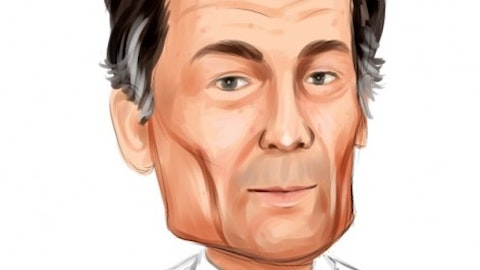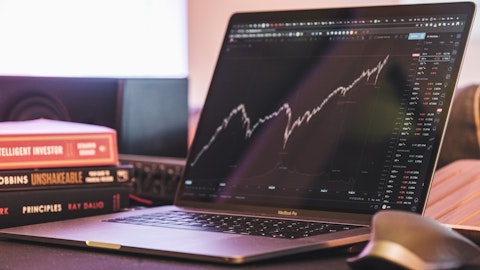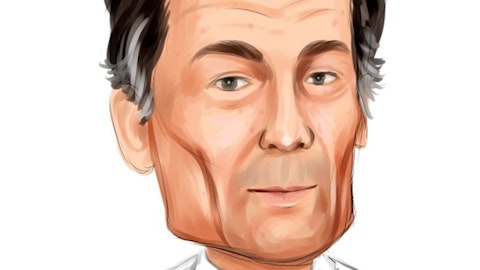Luminar Technologies, Inc. (NASDAQ:LAZR) Q4 2023 Earnings Call Transcript February 27, 2024
Luminar Technologies, Inc. misses on earnings expectations. Reported EPS is $-0.2 EPS, expectations were $-0.19. Luminar Technologies, Inc. isn’t one of the 30 most popular stocks among hedge funds at the end of the third quarter (see the details here).
Aileen Smith: Welcome, everyone, to Luminar’s Fourth Quarter and Full-Year 2023 Business Update Call. My name is Aileen Smith and I am Luminar’s Head of Investor Relations. With me today are Austin Russell, Founder and Chief Executive Officer; and Tom Fenimore, Chief Financial Officer. As a reminder, this call is being recorded and you can find the shareholder letter that accompanies this call at investors.luminartech.com. Hopefully, most folks have had a chance to review our shareholder letter as we are continuing with our new earnings format this quarter. As with last quarter, we will spend the majority of the call addressing questions from our stakeholders, including the retail investor questions, posted on the SAFE platform, institutional investor questions emailed to our investors inbox, and live questions from our analyst community.
We will be checking these platforms intermittently throughout the duration of the call to address any questions that come in real-time. Austin wanted to begin our call with some welcome remarks, including a look back on ’23 and a look ahead into 2024. Before I pass the call over to him, I wanted to remind everyone that during the call we may refer to GAAP and non-GAAP financial measures. Today’s discussion also contains forward-looking statements based on the environment as we currently see it, and as such does include risks and uncertainties. Please refer to our shareholder letter for more information on the specific risk factors that could cause actual results to differ materially. With that, I’d like to introduce Luminar’s Founder and CEO, Austin Russell.

Austin Russell: All right, well, thanks Aileen, and great to see all you guys here. So maybe just a quick opener before we jump into Q&A. If you’ve had a chance to be able to take a look at that letter kind of informational packet. The team and I have been really quietly heads down, focused on execution and the core execution for our business with all eyes on the industry’s first production vehicle launch, with Luminar and Volvo as standard on the new EX90. And it’s funny, as I think this is going to be one of the, maybe even the last earnings calls that where we’re a pre-production R&D company before we truly enter our growth stage. And I’d say it’s become abundantly clear that we’ve all seen all the challenges that the automotive industry has faced historically in being able to develop, industrialize, and enable this whole next generation capabilities on vehicles and bring it out into the commercial world and into consumers’ hands and really all this has been laid bare to the public in recent history, in the media and whatnot.
A lot of this just comes down to the ambition of what most have been in the industry have been trying to do of replacing the driver altogether with robo-taxis and this is where from Luminar from the beginning, we’ve taken a strategy of enhancing the driver and really focusing in on production vehicles. And that’s where Luminar is succeeding, where the rest of the industry hasn’t. In the last 10-years of what we’ve done at Luminar have really been leading up to this global launch on production vehicles right around the corner with Volvo, and we’ll be covering this at Luminar Day. To-date, we’ve invested over a billion dollars to develop a technology foundation, product industrialization capabilities, and this year it’s showtime. And it’s true that there are incremental costs, like maybe what you saw this quarter, that was more than the target and we don’t control all the timing for the vehicle launches and we’ve learned a lot through the years on how we can even be more efficient.
But now that’s in our rearview mirror. And for the first time, our multibillion-dollar order book is going to be converting to revenue this year. For the first time, we’re going to start seeing the benefits around the world into consumers’ hands. And, of course, automakers are going to be, well, maybe I shouldn’t say, of course, but in the case of Luminar, automakers are going to beginning to directly market our technology to their consumers. And this initial EX90 launch is going to be preceded by a flurry of additional mass-produced vehicle launches with automakers around the world over the coming 36 months following this. So, yes, it’s very exciting time. Certainly going to be enabling a lot of additional operational and economic efficiencies and exponential economic growth as we start realizing these benefits of the economies of scale with this program.
See also 18 Most Tax-Friendly States to Retire in 2024 and 13 Best Electronic Stocks To Buy Now.
Q&A Session
Follow Luminar Technologies Inc. (NASDAQ:LAZR)
Follow Luminar Technologies Inc. (NASDAQ:LAZR)
So very excited, everyone. Stay tuned for a special Luminar Day on April 23. And happy to be able to jump in with Tom here to be able to talk through the business, what’s ahead, and sort of what we’ve had. As it relates, of course, to this year, we were able to hit the majority of the overall milestones that we had throughout 2023 and we can give a little bit more commentary and questions on all of that. Again, the critical part is all around the core execution leading up to this launch. But we have also, in addition to that, been able to continue to scale our business, adding additional vehicle models, commercial programs overall to our business plans. But again, the critical part is all about execution. That’s what the industry hasn’t done historically to be able to successfully launch, and that’s what we’re excited to be able to make happen for the first time.
I think we’re ready for Q & A, Aileen if you want to start us off.
A – Aileen Smith: Great, thanks, Austin. So we are going to begin with a couple of questions from our SAFE platform. First question was reiterated in a couple of different capacities, but as such, I think there exists an information gap between the performance of the company and how it’s being evaluated by Wall Street. Are there any plans to bridge this divide and bring new investment into the company and stock?
Austin Russell: Yes, I think, you know, Tom knows this just as well as I do. And obviously, we all have very much shared in the frustration from some of this kind of market dislocations and whatnot. And the reality is that there has been a disconnect in value over the last few years relative to what we’ve been able to accomplish. I mean, everything from, again, scaling from technology to product to going into now serious production, going from what, like an order book of less than $100 million to $4 billion, from being able to actually successfully invest, develop, and deliver on these kinds of capabilities. And that’s not to say that there’s a lot more to do. We got a lot to prove out. But there’s also a lot of other factors that come into play and certain technical factors that I’ve had, for better or worse, too, I’ll learn about through the way.
The important part is, I think when you talk about value, Luminar as a company is operating in a way to be able to deliver that long-term value overall to our shareholders. And that’s our north star in that and that’s exactly what we’re doing to be able to use, I would say also comparable companies historically to what the Nvidia’s, the Tesla’s, the Mobileye of the world have done at equivalent stages as benchmarks towards our journey to success. And as we execute, we have the opportunity to be able to become exactly like that.
Aileen Smith: Okay, our second question from the SAFE platform in its 10-K, filed on February 23, Mobileye noted that it’s no longer actively working with Intel on its FMCW LiDAR development. Further, they noted that Mobileye is pursuing a different LiDAR technology. Can you please elaborate on how this affects Luminar?
Austin Russell: Yes, so when it comes to Mobileye, I probably can’t comment on our partner’s internal business. But when it comes down to, I will say that that’s probably just yet another validating point, that this stuff is hard like it’s not easy to be able to take things from people dramatically underestimate what it takes to go from powerpoints to technologies to industrialized products for scale. And I would just say that’s not even specific to any individualistic company, but also more generally the industry at large. And obviously, as more and more people realize this, it’s ultimately more and more beneficial to Luminar where we have done that. And I think that this is, again, all the more important to be able to show how we can successfully want to launch people are reading the tea leaves in the industry too, for that matter, because it costs real money to keep running these programs, too.
Aileen Smith: Okay. With that, we’re going to switch gears and take a couple of questions from our analyst community. I will remind our analyst community that we will allow one initial as well as a couple of follow-ups. Our first question is going to come from John Babcock at Bank of America.
John Babcock: Hey, good afternoon, guys. I guess, just the first question I had on order book, I noticed there was a change in the way that you’re calculating that. And last quarter you provided guidance that you expected to have this year at around a billion plus in additional order book, I think you mentioned it was around $800 million. Was just wondering how much of the impact or the gap there was from the change in the calculation. And also, if you could just provide specifically how much that calculation overall impacted 2023? That’d be great.
Tom Fenimore: Sure. And John, it’s Tom. Let me start off with that. And first, let me talk about how we’ve done it differently. We ended ’23 with about 25 awarded vehicle lines or commercial programs. And what we’ve done this year that is different than what we’ve done last year. And this is just part of us being on that verge of the SOP and continuing to mature is we listed each of those vehicle lines. We then went to IHS, as I would say, the ground truth for the volumes to use in calculating our order book, as well as our internal forecasting. So we used IHS as the source of those volumes for SOP dates and EOP dates for the vehicle lines that we have awarded. If we’re standard, like on the Volvo EX90, you just take 100% of that.
If you are not standard, what we’ve done is we’ve assumed a blanket 25% take rate. We looked at market data, we looked at what our customers are telling us. It typically ranged between 5% and 50%. We kind of used 25%, which is a little less than the midpoint. Put a pin in that we’ll talk about a sensitivity analysis in a sec. And then we rolled up the order book that way. That resulted, I would say if you kind of look at on an apples-to-apples basis relative to the business we already won about a $400 million decrease because I would say, on average, ISS has more conservative volume estimates than I would the more the customer-derived ones that we’ve used historically. If you look at what our total gross wins were during 2023, it was about $800 million.
It was still a little bit shy than the billion that we forecast because some decisions we were expecting to make in ’23 have been deferred into ’24. We really didn’t lose anything that we wanted to win. But I would say that more conservative forecast there kind of was about a $400 million headwind in terms of order book size that we’ve reported. Now going back to the take rate of 25%. If you want that to be 5% higher to 30% or 5% lower to 20%, or whatever number you want to choose, a 5% change in that assumption impacts the size of our order book by about $400 million. So we wanted to give that additional disclosure so that people can make their own estimates of the order book size there. But I would say it’s a more analytical bottoms-up based on more third-party sources for volumes, as opposed to kind of using what our customers have provided us.
Austin Russell: And on that note, what’s great is we want to help set the standard in the industry when it comes to order book type of calculations because we’ve seen sort of, I would say, radically different views of what those can amount to and that’s why it’s like, oh, if you use the same kind of calculation that then our order book would be $100 billion or something at this point, which is that at that point, it just becomes irrelevant. We’re probably not even, probably still getting a fraction or not much credit at all today for even the order book that we have. So that’s where I think what is cool is that now, whereas I think when we were first doing this, even before Tom was on board, some years ago, there weren’t IHS volumes didn’t exist for any of these things. And now, okay, like these models are starting to come to fruition, and that’s what’s at least exciting to me and starting what, in months in the countdown.
John Babcock: That’s very helpful. Thanks for all the color. I guess, just last question before I turn it over. I think one of the difficult aspects of certainly your industry is trying to kind of gauge how the adoption is for the different companies and how they’re kind of thinking about that. Just kind of curious, is there any change in how companies are anticipating the adoption of autonomy? It seems like it’s getting pushed off broadly, but just wondering if there has been any material change over the last quarter. So we’ve read about EVs flowing, and that does have some natural flow through, given the technology adoption in EVs relative to currently for ICE vehicles anyway. But just overall, if you could kind of talk about how that cadence has changed, if it has changed at all from last quarter? That would be useful.
Tom Fenimore: You want to go or you want me to do?
Austin Russell: Well, maybe I’ll start off that. I would say when it comes to the overall industry, we actually, we have the roll-up on this. Now, the majority, and actually around 80% of the Top 20 automakers are planning on integrating either LiDAR or just long-range LiDAR, generally by 2030, you know, and have it on the roadmap to be able to do that into their production vehicles. So there definitely is a — and for the remaining portion, I think it’s like the remaining 15% is they’re figuring out and 5% isn’t. But there’s no shortage of interest in demand and everything in terms of what ultimately, the ability for these technologies to get integrated across vehicles is like. The whole job of what we have is how do we find ways to further accelerate that adoption curve.
I mean, naturally, to the point of, like one thing that I think a lot of people in the tech industry don’t appreciate as much since we’re kind of this weird mix of both a technology company and an automotive company at the same time, is that automotive design cycles are very long as I know, you know, of course. And this is where you take a look historically at the adoption cycles for new kinds of technologies in the automotive industry and you’re talking about, like, 20-years from the time that something is first introduced to when it was standardized, ultimately on every vehicle. And I think for LiDAR generally, I think we’re actually seeing a faster adoption curve than probably any other technology maybe in automotive history, or even just the overall concepts of like, I think, what like, battery electric vehicles are still like only a single digit percentage of vehicles sold after 20-years.
Like, this stuff takes time, but the economics are massive when you’re able to realize it and that’s why it’s just so powerful to have real market penetration into this. And that’s where I’d also say it kind of goes back to one of the things I put in the letter is quality over quantity, because you could have a dozen different OEMs that you’re working with. But if it’s, like, just on a single low-volume vehicle like that may or may not you know happen that’s only so meaningful if you are able to successfully come to fruition and realize the value and benefits of the partnerships that you have. I mean, you’re talking about tens of billions of dollars in value that you can successfully realize even from, for example, just in our case, just the existing customers that we’re working with.
So that’s where it’s going to be important. I think, to the overall point, though, on EVs and the last point that I want to address, to your point, that is very real in terms of the growth headwinds that I think a lot of EV companies are facing and I mean, ultimately, you’re the analyst on that, not me but from our conversations with some of the like pure EV companies, that’s always the case. I think, though, that what is important and this is very much also a misconception, I think, about Luminar generally, is the idea that we are only for EVs, the amount of company, the amount of people that I’ve actually had that have literally gone out and called Luminar like an EV company or like EV tech company is surprising, you know. So, I think what is actually probably very surprising to many is that for the majority of vehicle platforms that we’re on, they’re actually, they do include combustion vehicle models or variants and that’s where there I think that there is going to be a lot of value growth and the reality is that it is true that combustion engine vehicles aren’t like, just disappearing overnight.
But our technology and the safety benefits of this technology and the time-saving benefits of this technology is independent of powertrain. So it’s independent whether it runs a dinosaur, druce, or lithium-ion. So that’s sort of the perspective that we have and I think doesn’t sort of materially affect the value or value proposition of what we’re doing overall, so. But, yes, that’s the perspective.
John Babcock: Yes, thank you.
Aileen Smith: Our next question comes from Joshua Buchalter at TD Cowen.
Joshua Buchalter: Hey, guys, thanks for taking my questions. To start following up on the sort of John’s first one, unless I missed it in the shareholder letter, you didn’t provide an order book target for this year. I was wondering if you could maybe speak to the rationale behind why you’re not providing it this year. And maybe if you’re not going to quantify, are there any sort of qualitative commentary you can give on upcoming RFPs and RFQs that you can help us better understand sort of the business funnel? Thank you.
Austin Russell: Yes, look, Josh, I think it’s fair to say we’re going to significantly grow our order book this year. 2024 is where we’re going to be actually transitioning the order book from potential revenue into actual revenue. And so what we’re going to be talking a lot more about this year is what our revenue is going to look like, particularly from series production revenue. We gave some guidance for what we expect that to be on a quarterly run rate in the latter half of this year, particularly in the mid-30 range. Look, we’re confident that Volvo is going to start production on the EX90 in Q2. I think the ramp-up and the exact pace, as we get more confidence and clarity on what that exactly is going to be, we’re going to refresh that as well.
The order book is going to go up significantly. And what I would say is, in the conversations, we’re having with customers, both newer customers and existing customers, there are some macro headwinds that we talked about before, like EV headwinds, and how that impacts our product planning as well as, I would say, some of the software complexity around getting these systems that right. But I would say when it comes to Luminar, they want to actually see us get the high-volume production, which we will in the coming weeks. And I think they want more clarity around our next generation ladder is going to look like and we’ll talk more about that at Luminar Day. Once we get those two things, that’s going to unlock a lot more business. And as we win it, we’ll set more specific targets.
Joshua Buchalter: Understood. Thank you for all the color there, Tom. Actually, another one for you. You called out the goal, I think, of $150 million in liquidity exiting the year. Any more details you can provide on sort of how we bridge that number? And maybe you can give us details on your expectations for OpEx trajectory because you’re in the ramp phase. But you also mentioned that industrialization costs should be coming down, and it sounds like there’s also some belt-tightening. So it’d be great to hear some more color on how you expect to get to the $150 million number. Thank you.
Tom Fenimore: Yes. The starting point we’re using there is the $340 million, which is the $290 million of cash and the 50 million of credit facility that we recently put in place. Our prime objective has always been get to Volvo SOP. And if we have to spend a little bit more to get there at the sacrifice of our near-term results like what we did in Q4, we’re going to make that. But now that we’re getting really at Volvo SOP, we’re really going to start the belt-tightening. We’re going to start aggressively attacking our unit economic costs, particularly the bomb and the manufacturing conversion costs. And then we’re going to look to streamline Luminar and really assess what is core to us and then what are some things that can be done better in other ways.
And we’re going to start really looking at how we can streamline the organization. That, as well as the wind-down of some of the iris industrial costs are going to continue to have our net cash spend in the right direction. It started that way in Q4. We were hoping it will be a little bit better, but it was still a big improvement from what the first half of the year looked like there. I would say our internal targets are a lot more aggressive than the $150 million we have here. But I think once again, we want to get a little bit more clarity on exactly what that Volvo ramp-up is going to look like and then what the corresponding cost ramp-down looks like. And then we’ll provide more clarity on some of the actions we’re taking here in a little bit.
Joshua Buchalter: Yes. Thank you. I’ll see the floor.
Austin Russell: Absolutely. And I’ll also say that obviously, when it comes to just the overall business and environment, I think I just want to make sure there’s kind of broader where we’re not oblivious to the overall change in macro environment, which we know there has been a significant change, there’s been changes in industries, changes other stuff. Not all of it is explained like I said, from a market standpoint, but just more generally, I think it’s totally fair to say that the kinds of investments that we’re going to be doing going forward are going to be done on a much more conservative basis like. And sometimes, to be honest, it’s painful because it’s like, we know this is good, this is absolutely going to have a great five to 10-year payout if we do X, Y, and Z.
But like that’s the kind of thing that maybe brings you from like a $10 billion company to like a $20 billion company like, I think that the point is that let’s focus on the core of what’s driving and validating the value of what we have. Let’s focus on validating the order book. That’s the same reason why, like, honestly, we could continue to add billions of dollars to the order book for everything. That’s fantastic. But we’re not actually even really getting credit for even a fraction of what we have today. So that’s why I think focus on the core, focus on validation. And I think, just to be frank, there definitely are greater efficiency opportunities, in particular, given this over a billion-dollar investment that we’ve made historically, we’re past that peak of cash spent, and we’re riding that tailwind from that big investment that we’ve made to be able to realize the full benefit for the next decade to come from that technology foundation, product foundation, and industrial capabilities that we built.
Joshua Buchalter: Thank you.
Aileen Smith: Our next question comes from Itay Michaeli at Citibank.
Itay Michaeli: Great. Thanks, Aileen. Hey, everyone. Just a couple of follow-ups for me. First, on gross margins. I know in the past you have provided some targets there. If you do hit kind of when you hit the mid-$30 million target, any color, you can share, Tom around how we should be thinking about kind of gross margin for the company at that point.
Tom Fenimore: Yes, look, we’re hoping to see some improvements in Q4. It took a little bit more effort to get ready for the Volvo SOP, which, as I mentioned before, was the prime directive and the right priority here at Luminar. It’s all going to be dependent, Itay, on how quickly that volume ramps up and how quickly we can ramp down the cost. Both the unit economics as well as some of the fixed costs that we have embedded in our COGS, which is a fair amount. And so we are actively working on a plan to make that happen as fast as possible. And as we get more clarity on the ramp-up at Volvo and the corresponding ramp-down in the cost, which is going to be the biggest driver on that, we’ll get more clarity but you know, I think it’s very safe to say that you’re going to see a fair amount of improvement as we get into the latter half of the year.
Austin Russell: Absolutely. The other thing that I note more generally is that there’s really — this overall notion of COGS is extremely confusing to a point where like I even sort of have to dissect it of what are all the different components that go into this and turns out there’s actually a surprising amount of components that go into this, particularly from the industrialization side as well. You’re talking everything from literally consulted costs all the way through like, other, you know, one-off costs that you have to be able to accomplish. And I think that that’s the part that we’re really focused on driving. Of course, we’re also focused on driving further the unit economics, but even today, I mean, it is incremental from a variable cost perspective, it is incrementally positive already, which was how we originally underwrote some of the thinking around gross margin more generally on a product basis across the board for the different kinds of product capabilities that we have.
So that’s what is positive and obviously not what is immediately obvious, but I think that’s where we’re going to also have to figure out how we can better break out some of the industrialization costs, and, but most importantly, make sure that cost is still cost and we want to be able to realize the economy is a scale of Volvo and drive that down by the time that happens within the first-half of the year.
Itay Michaeli: Got it. That’s all very helpful. Thanks for the detail. Maybe just a quick follow-up going back to the order book. To what extent was the shortfall in ’23 tied to the timing of the next-generation LiDAR? And if it was, how should we think about when your customers can kind of make decisions, sourcing decisions around that next-generation LiDAR?
Tom Fenimore: Yes, look, and we’ll talk more about that. I think that’s a very good question and observation there, Itay. What I would say is I’ve always described our next-gen LiDAR as kind of like a smaller, better, cheaper and we’re looking to accelerate that in terms of some of the commentary streamlining, making sure that we can industrialize our products faster, applying the lessons we’ve learned after over the last three years, going through what we went with on Iris to make sure that we can get it to the market as fast as possible because our customers really like that product. They really want it and I would say the timelines that we’re working on for that are starting to align with their product planning cycle. It’s not exactly there yet, but it’s going to be there pretty soon, and I would say waiting a few months to get that next better product, as opposed to kind of taking ours, which is a great product today, but taking that for six, 12 months and then transitioning to the next generation one when there’s a natural slowing as people revisit their product planning because of the EV headwind, some of the software struggles they’re facing, that is kind of aligning.




